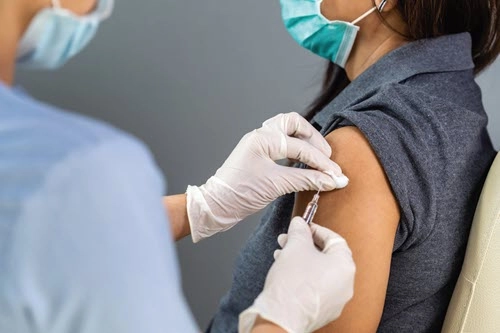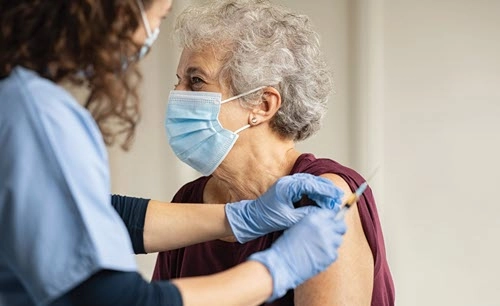Strive for Transparency in Vaccination Information
Don’t throw away your mask just yet. If you have questions about how receiving the vaccine for COVID-19, the infection caused by the virus SARS-CoV-2, you’re not alone. If you have concerns about side effects, questions about immunity, or want to know whether you can finally abandon your mask, keep reading for the best information available right now. Know Difference Between Post-Vaccination and COVID Symptoms One worry that nonclinical people may have is whether they risk getting COVID-19 from the vaccination itself. This fear is exacerbated by potential — but totally normal — side effects from the vaccine. Vaccinations sometimes cause an immune response in recipients, and the COVID-19 vaccination is no different. However, the symptoms of a response to the vaccine will not mirror COVID-19 symptoms. The signs and symptoms people may experience after receiving the vaccine are systemic and can include fever, fatigue, headache, chills, myalgia, and arthralgia, said David T. Kuhar, MD, a member of the healthcare infection control team for COVID-19 Response at the Centers for Disease Control and Prevention (CDC) in Atlanta, in a recent Clinician Outreach and Communication Activity (COCA) call. Most of these signs and symptoms would be mild or moderate, would present in the first three days after vaccination, and should resolve within a day or two after onset, Kuhar said. More adverse reactions have been reported after the second dose, and more in people 18-55, rather than older than 55. Symptoms and signs that can be the hallmarks of COVID-19, like cough, shortness of breath, runny nose, sore throat, and loss of taste or smell would be attributable to something else besides the vaccine, Kuhar said. It’s important to be transparent with staff, especially, about what they should expect after vaccination. “Let them know what to expect and what to do as symptoms develop. Also, developing a strategy to provide timely assessment of healthcare personnel who present with symptoms, including providing or identifying options for SARS-CoV-2 viral testing, so it’s readily available if indicated,” Kuhar said. One helpful thing to note when planning vaccination of staff and residents is that the COVID-19 tests will still be accurate. “Positive nucleic acid and antigen testing for SARS-CoV-2 should not be attributed to the COVID-19 vaccine, as the vaccine does not influence the results of these tests, and this is important, because we can still test vaccinated persons for acute disease when indicated,” Kuhar said. Build this consideration into your vaccination protocols, along with monitoring the timing of any symptoms or signs. Keep following the same protocols for symptomatic and asymptomatic staff, too, with a special eye on fevers. “If symptomatic personnel return to work and symptoms are not improving or persist for more than two days, which is more than you’d expect from postvaccination signs and symptoms, then pending evaluation, they should be excluded from work and considered for viral testing. Personnel with fever should ideally be excluded from work, pending evaluation, including consideration for SARS-CoV-2 testing,” Kuhar said. Continue to Use PPE Unfortunately, getting vaccinated is not yet a golden ticket to stop wearing a face mask or other personal protective equipment (PPE) — or for your facility to stop purchasing it and keeping a stocked inventory. There’s not enough information available yet for definitive proof that the vaccine is effective enough to preclude PPE usage. “It’s really important to remember that because information is lacking on vaccine effectiveness in the general population, resultant reduction of disease, severity, or transmission, even the duration of protection, residents and healthcare personnel should continue to follow all current infection prevention and control recommendations to protect themselves and others from SARS-CoV-2 infection regardless of their vaccination status,” Kuhar said. Mark Parkinson, president and CEO of the American Health Care Association and National Center for Assisted Living (AHCA/NCAL), in a recent press release, echoes the reality that the significant costs will remain. The arrival of the vaccine is a turning point, but not the end, he says, and calls on Congress to provide funding beyond what’s included in the mid-December COVID relief package, pointing out that PPE will still be a necessary and ever-mounting expense. “While we appreciate the difficulty in reaching a bipartisan compromise, we are disappointed that Congress could not strike a deal that recognizes the dire situation our long-term care residents and staff are facing right now. Due to soaring community spread, nursing homes are experiencing a record-breaking number of cases and deaths — worse than the spring. Even with a vaccine on its way, it will likely take months to fully vaccinate our residents and staff, as well as the remaining public. Facilities will not be able to return to normal for some time, meaning providers need ongoing support with PPE, testing and staffing,” Parkinson says. “Meanwhile, nearly two-thirds of long-term care facilities are operating at a loss, and the additional funds slated for the Provider Relief Fund for all heath care providers in this legislation are minimal. Hundreds of facilities are in danger of closing their doors permanently and uprooting the frail seniors they care for. Congress must do more in the new year by directing specific aid to long term care. We owe it to our nation’s seniors and our health care heroes,” Parkinson says. Communicate Realities With Residents, Too If your state is prioritizing long-term care residents to receive the vaccination as well, you’ll need to be able to communicate the potential signs and symptoms of a physical response to receiving the vaccine to residents and their representatives, as well. This includes being able to differentiate between postvaccination symptoms and COVID-19 symptoms — and for facilities to act quickly and nimbly to enact transmission-based protocols to lower risk of exposing other residents to the virus, without resorting to unnecessary over-testing, Kuhar said. However, if residents are showing symptoms more consistent with COVID-19 than a postvaccine response, facilities should test for a variety of viruses, including SARS-CoV-2, and move the residents to single-occupancy rooms, if available. Staff interacting with these residents should follow the facility’s PPE protocols for residents with known or suspected COVID-19. But don’t cohort with any other residents who are confirmed positive for COVID-19 through testing, Kuhar said, unless the resident in question is also confirmed positive. If the symptoms resolve within two days of appearing, then you can stop the transmission-based protocols, Kuhar said, but, if the resident had a fever, wait a full 24 hours after the fever resolves. Don’t miss: If you are cohorting, you cannot code the respective residents as being in isolation for MDS item O0100M (Isolation for active infectious disease (does not include standard precautions)), reminds Jane Belt, MS, RN, QCP, RAC-MT, RAC-MTA, curriculum development specialist at American Association of Post-Acute Care Nursing (AAPACN) in Denver. Resource: For information on mitigating vaccine hesitancy and education, as well as a letter template to send to residents and their families, find American Association of Post-Acute Care Nursing (AAPACN) guidance here: www.aapacn.org/coronavirus-resources-for-ltpac.


